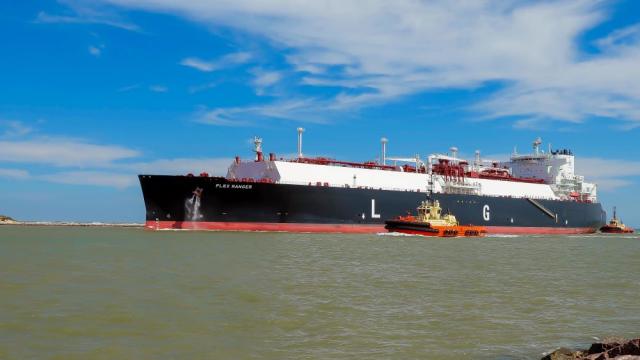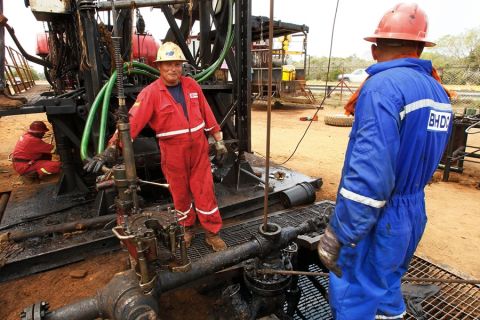
The Flex Ranger LNG tanker in Port Aransas, Texas in 2020. (Source: Shutterstock.com)
Completion of construction work on three LNG liquefaction projects on the U.S. Gulf Coast will add a combined 5.7 Bcf/d of export capacity by 2025, according to Washington-based Energy Information Administration (EIA), further supporting the U.S.’ growing dominance of the sector.
Despite the lead time, LNG exports from the three projects will likely be destined for energy-short countries in Europe, Asia and Latin America amid a global supply crunch exacerbated by Vladimir Putin’s military offensive in Ukraine and subsequently reduced Russian energy exports amid heightened geopolitical tensions in the region.
RELATED
Europe Remains Keen on US LNG Despite Reduced Flows
“Given the challenges in procuring energy (a very high dependence on imports), particularly natural gas, cold across several densely populated areas (U.S. Northeast, Central/Western Europe, East Asia) will be very important to watch during the upcoming winter, in our view,” Wells Fargo equity analysts Roger D. Read and Lauren Hendrix Walker wrote Sep. 9 in a research note to clients, referring to the shutdown of gas flows from Russia to Germany along Nord Stream 1.
“Given the interdependency of LNG deliveries, we believe colder than normal weather in one region has the potential to cause price and supply ripples throughout other regions,” they continued.
Although a relative newcomer to the LNG export game, the U.S. now boasts the world’s largest liquefaction capacity, according to the EIA, citing data from CEDIGAZ. In addition, the country also asserts itself as the world’s largest LNG exporter during the first half of 2022, shipping out an average 11.1 Bcf/d between January and July 2022, according data posted Sep. 6 to the U.S. agency’s website.
The three U.S. Gulf Coast LNG export projects in question include Golden Pass LNG, Plaquemines LNG and Corpus Christi Stage III, of which two are located in Texas and one in Louisiana.
Golden Pass LNG
Qatar Petroleum and Exxon Mobil are behind the Golden Pass LNG brownfield project that will consist of three standard-sized trains with peak nameplate capacity of 0.80 Bcf/d each. Combined the project will add peak capacity of 2.39 Bcf/d by 2025. Train 1 is expected to start service in 2023 while Train 2 and Train 3 are slated to start in 2024.
“Golden Pass LNG is on the site of an existing regasification facility and will use shared infrastructure, which helps to reduce project costs and shorten the construction timeline,” the EIA said.
Plaquemines LNG
Venture Global LNG is behind the Plaquemines LNG Phase I greenfield project that will consist of 24 mid-scale trains with peak nameplate capacity of 0.07 Bcf/d each. Phase I of the project will add 1.76 Bcf/d and is expected to start service in 2024.
Each liquefaction train will form part of a two-unit block for a total of 12 blocks, according to the EIA. The project will utilize modular technology with mid-scale refrigeration trains, which “has a shorter project construction timeline,” according to the EIA.
Corpus Christi Stage III
Corpus Christi Liquefaction Stage III, LLC is behind the Corpus Christi Stage III brownfield project on the site of an existing terminal with three liquefaction trains already operational.
The project will consist of 14 new, mid-scale trains with peak nameplate capacity of 0.11 Bcf/d each. Combined the project will add 1.51 Bcf/d and is expected to start service in 2025. Each train is part of a two-unit block for a total of seven blocks, according to the EIA.
Recommended Reading
US Decision on Venezuelan License to Dictate Production Flow
2024-04-05 - The outlook for Venezuela’s oil industry appears uncertain, Rystad Energy said April 4 in a research report, as a license issued by the U.S. Office of Assets Control (OFAC) is set to expire on April 18.
Renewed US Sanctions to Complicate Venezuelan Oil Sales, Not Stop Them
2024-04-19 - Venezuela’s oil exports to world markets will not stop, despite reimposed sanctions by Washington, and will likely continue to flow with the help of Iran—as well as China and Russia.
US Orders Most Companies to Wind Down Operations in Venezuela by May
2024-04-17 - The U.S. Office of Foreign Assets Control issued a new license related to Venezuela that gives companies until the end of May to wind down operations following a lack of progress on national elections.
US Threatens to Not Renew Venezuelan Energy Sector License
2024-01-31 - The U.S. Department of State alerted Venezuela that it could decide not to renew General License No. 44 amid what Washington has labeled “anti-democratic actions.”





